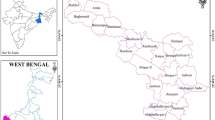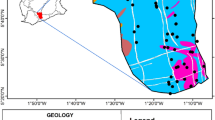Abstract
Assessment of groundwater vulnerability to pollution is an essential pre-requisite for better planning of an area. We present the groundwater vulnerability assessment in parts of the Yamuna Nagar District, Haryana State, India in an area of about \(800 \hbox { km}^{2}\), considered to be a freshwater zone in the foothills of the Siwalik Hill Ranges. Such areas in the Lower Himalayas form good groundwater recharge zones, and should always be free from contamination. But, the administration has been trying to promote industrialization along these foothill zones without actually assessing the environmental consequences such activities may invite in the future. GIS-DRASTIC model has been used with field based data inputs for studying the vulnerability assessment. But, we find that inclusion electrical conductivity (EC) as a model parameter makes it more robust. Therefore, we rename it as GIS-DRASTIC-EC model. The model identifies three vulnerability zones such as low, moderate and high with an areal extent of 5%, 80% and 15%, respectively. On the basis of major chemical parameters alone, the groundwater in the foothill zones apparently looks safe, but analysis with the help of GIS-DRASTIC-EC model gives a better perspective of the groundwater quality in terms of identifying the vulnerable areas.
















Similar content being viewed by others
References
Alam F, Rashid U, Shakeel A and Ahmad F D 2012 A new model (DRASTIC-LU) for evaluating ground water vulnerability in parts of central Ganga Plain, India; Arab. J. Geosci, https://doi.org/10.1007/s12517-012-0796-y.
Aller L, Bennett T, Lehr J H and Petty R J 1987 DRASTIC: A standardized system for evaluating ground water pollution potential using hydrogeologic settings, U.S-EPA/600/2-87/035, June 1987, Robert S Kerr, Environmental Research Laboratory, Ada OK 74820.
APHA (American Public Health Association) 1992 Standard methods for the examination of water and wastewater; 16th edn, APHA, Washington, D.C.
BIS 2012 Indian standard drinking water-specification (2nd Revision) BIS (IS-10500, 2012), New Delhi.
Bhatnagar N C, Agashe R M and Mishra A K 1982 Subsurface mapping of aquifer system: Water balance study of Upper Yamuna Basin, Section: Hydrogeology; Technical report No. 2, Upper Yamuna Project: Central Ground Water Board, North Western Region, Chandigarh.
CGWB (Central Ground Water Board) 2014 Report on Dynamic Ground Water Resources of Haryana State as on March 2011; Central Ground Water Board, North Western Region, Chandigarh.
Chakraborty S and Sikdar P K 2007 Assessing aquifer vulnerability to arsenic pollution using DRASTIC and GIS of North Bengal Plain: A case study of English Bazar Block, Malda District, West Bengal, India; J. Spatial Hydrol. 7(1) 101–121.
CoI (Census of India) Haryana 2011 District Census Handbook-Yamuna Nagar, Village and Town Directorate, Directorate of Census Operations, Haryana, Series-7, Part-XII-A, Page. No. 12, http://www.censusindia.gov.in/2011census/dchb/DCHB_A/06/0603_PART_A_DCHB YAMUNANAGAR.pdf.
CPCB (Central Pollution Control Board) 2013 Pollution Assessment: River Ganga. CPCB, Ministry of Environment and Forest, Govt. of India, 197p.
Gogu R C and Dassarguess A 2000 Current trends and future challenges in ground water vulnerability assessment using Overlay and index methods; Environ. Geol. 39(6) 549–559.
GWREC (Ground Water Resources Estimation Committee) 1997 Report of ground water resource estimation committee; Ministry of Water Resources, Government of India, New Delhi.
Herojeet R, Rishi M S, Lata R and Sharma R 2016 Application of environ metrics statistical models and water quality index for ground water quality characterization of alluvial aquifer of Nalagarh Valley, Himachal Pradesh, India; Sustain. Water Resour. Manag. 2(1) 39–53, http://link.springer.com/article/10.1007/s40899-015-0039-y.
Hussain M H, Singhal D C, Joshi H and Kumar S 2006 Assessment of ground water vulnerability in tropical alluvial interfluves, India; Bhu-Jal News, Central Ground Water Resources, Ministry of Water Resources, 1–4 31–43.
Iqbal J, Gorai A K, Katpatal Y B and Pathak G 2014 Development of GIS-based fuzzy pattern recognition model (modified DRASTIC model) for ground water vulnerability to pollution assessment; Int. J. Environ. Sci. Technol, https://doi.org/10.1007/s13762-014-0693-x.
Kamaldeep, Rishi M S, Kochhar N and Ghosh N 2011 Impact of industrialization on ground water quality: A case study of Baddi–Barotiwala Indusrial belt, District Solan, Himachal Pradesh, India; J. Indust. Pollut. Control. 27(2) 153–159.
Khan M M A, Umar R and Lateh H 2010 Assessment of aquifer vulnerability in parts of Indo Gangetic plain, India; Inter. J. Phys. Sci. 5(11) 1711–1720, http://www.academicjournals.org/IJPS, ISSN 1992-1950 2010 Academic Journals.
Kumar Rakesh and Bhattacharya S 2008 To study heavy mineral suites and correlate the sedimentation patterns within Siwalik group of rocks in Ambala and Yamuna Nagar districts, Haryana, FS-2007-08, Petrology Division; Geol. Survey of India, Northern Region, Faridabad.
Kumar S and Das P 2007 Impact of effluents of Haryana distillery on groundwater quality in Yamunanagar city and surrounding areas, Haryana; Central Ground Water Board, North Western Region, Chandigarh.
Mendoza J A and Barmen G 2006 Assessment of ground water vulnerability in the Rio Artiguas basin, Nicaragna; Environ. Geol. 50 569–580.
MSME-DI (Micro, Small & Medium Enterprises) – Development Institute 2012 Brief industrial profile of Yamunanagar District, Ministry of MSME, Govt. of India, 28p.
NBSS and LUP (National Bureau of Soil Survey and Land Use Planning) 1994 Soil Map of the Haryana State; Publications of National Bureau of Soil Survey and Land Use Planning (ICAR) and Department of Agriculture, Haryana State.
NRDWP-MDWS (National Rural Drinking Water Programme – Ministry of Drinking Water and Sanitation, Govt. of India), 2015, Village level water quality data; http://indiawater.gov.in/imisreports/Reports/WaterQuality/rpt_WQM_ContaminationWiseLabTesting_S.aspx?Rep=0andRP=Y.
NRSC-ISRO (National Remote Sensing Centre – Indian Space Research Organization) 2008 Data accessed and downloaded for preparation of elevation map (Cartosat-1 Data: C1_DEM_16b_2006-2008_V1_77E30N_H43L), http://bhuvan.nrsc.gov.in/data/download/index.php.
NRSC-ISRO (National Remote Sensing Centre – Indian Space Research Organization) 2012 Land Use Land Cover (1:50000 scale): 2011–12 data, http://bhuvan.nrsc.gov.in/gis/thematic/index.php.
NRSC-GSI (National Remote Sensing Centre – Geological Survey of India) 2010 Manual for geomorphological and lineament mapping on 1:50000 scale; National Remote Sensing Centre and Geological Survey of India combined Project.
Qinghai G, Yanxin W, Xubo G and Teng M 2007 A new model (DRARCH) for assessing ground water vulnerability to arsenic contamination at basin scale: A case study in Taiyuan basin, northern China; Environ. Geol. 52 923–932.
Rahman A 2008 A GIS based DRASTIC model for assessing ground water vulnerability in shallow aquifer in Aligarh, India; Appl. Geogr. 28 32–53, https://doi.org/10.1016/j.apgeog.2007.07.008.
Saha D and Fakhre Alam 2014 Ground water vulnerability assessment using DRASTIC and pesticide DRASTIC models in intense agriculture area of the Gangetic Plains, India; Environ. Monit. Assess. 186(12) 8741–8763.
Sarma V V J and Narayanaswamy A 1981 Groundwater quality in Vishakhapatnam basin, India; Water Air Soil Pollut. 16 317–329.
Singh A, Srivastav S K, Sudhir Kumar and Chakrapani G J 2015 A modified DRASTIC model (DRASTICA) for assessment of ground water vulnerability to pollution in an urbanised environment in Lucknow, India; Environ. Earth Sci. 74 5475–5490, https://doi.org/10.1007/s12665-015-4558-5.
Thiessen A H 1908 Thiessen polygons definition; https://en.wikipedia.org/wiki/Voronoi_diagram and https://en.wikipedia.org/wiki/Alfred_H._Thiessen.
Todd D K and Mays L W 2015 Ground water hydrology, 3rd edn, Wiley, pp. 36–37.
Thomas Liz 2017 How to convert TDS to conductivity; Sciencing dated April 24, 2017, http://sciencing.com/convert-tds-conductivity-7381015.html.
Umar R, Ahmed I and Alam F 2009 Mapping ground water vulnerable zones using modified DRASTIC approach of an alluvial aquifer in parts of central Ganga Plain, western Uttar Pradesh; J. Geol. Soc. India 73 193–201.
Verma B C 1976 Geological mapping and systematic collection of vertebrate fossils and stone artefacts from the Upper Siwalik Formation and Yamuna river terraces of Solan and Sirmur districts of HP and Rupar district of Punjab; Unpublished Report; Geological Survey of India, (F.S: 1974-75).
Vias J M, Andreo B, Perles M J and Carrasco F 2005 A comparative study of four schemes for ground water vulnerability mapping in a diffuse flow carbonate aquifer under Mediterranean climatic conditions; Environ. Geol. 47 586–595.
Vrba J and Zaporozec A 1994 Guidebook on Mapping Ground water Vulnerability; IAH International Contributions to Hydrogeology FRG, Heise Publication, Hannover 16 131p.
Acknowledgements
We express sincere gratitude to Mr K B Biswas, Chairman, Central Ground Water Board (CGWB) for granting permission to publish this paper. Assistance received from Mrs. B P Singh and Mr. Rishi Raj from CGWB, North Western Region, Chandigarh for chemical analysis of ground water samples is gratefully acknowledged. Special thanks to colleague Dr Fakhre Alam for some of his useful suggestions. Thanks are due to Dr P Ganapathi Rao for his help in the textural analysis of soil.
Author information
Authors and Affiliations
Corresponding author
Additional information
Corresponding editor: N V Chalapathi Rao
Rights and permissions
About this article
Cite this article
Anantha Rao, D., Naik, P.K., Jain, S.K. et al. Assessment of vulnerability zones for ground water pollution using GIS-DRASTIC-EC model: A field-based approach. J Earth Syst Sci 127, 49 (2018). https://doi.org/10.1007/s12040-018-0944-1
Received:
Revised:
Accepted:
Published:
DOI: https://doi.org/10.1007/s12040-018-0944-1




